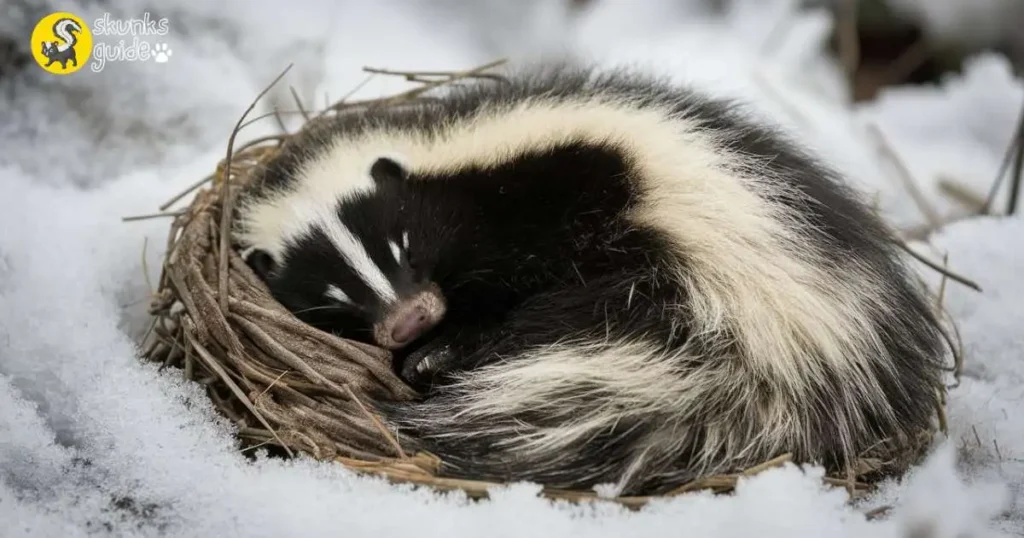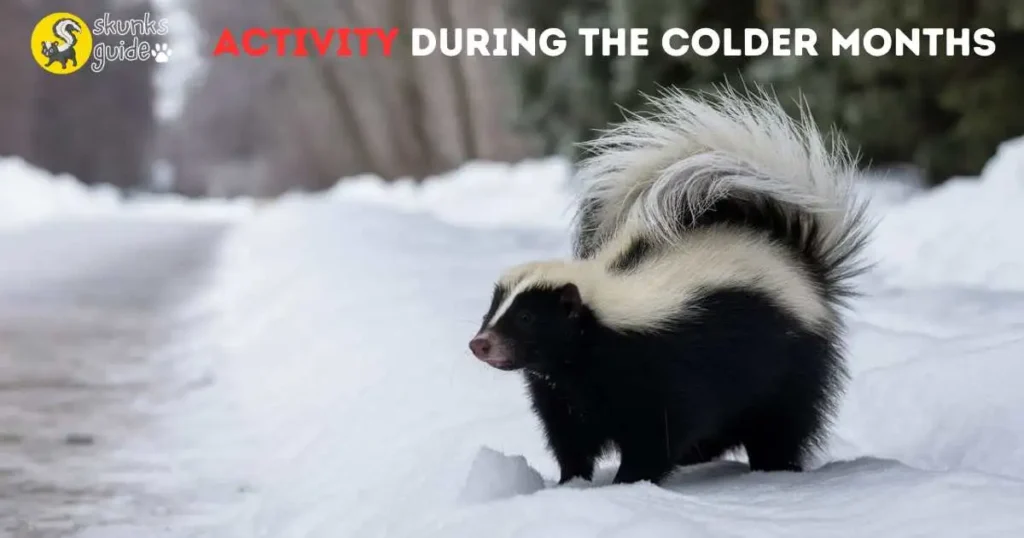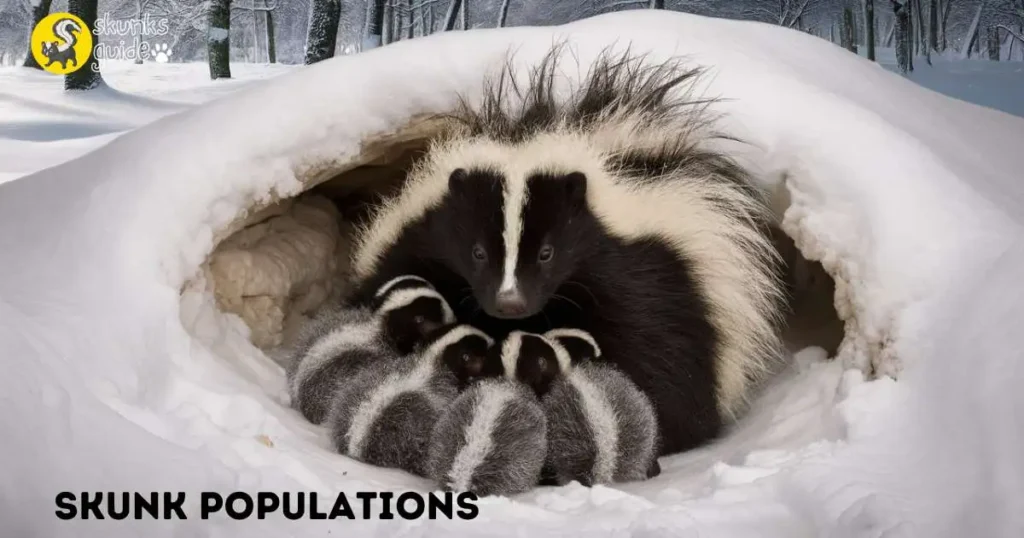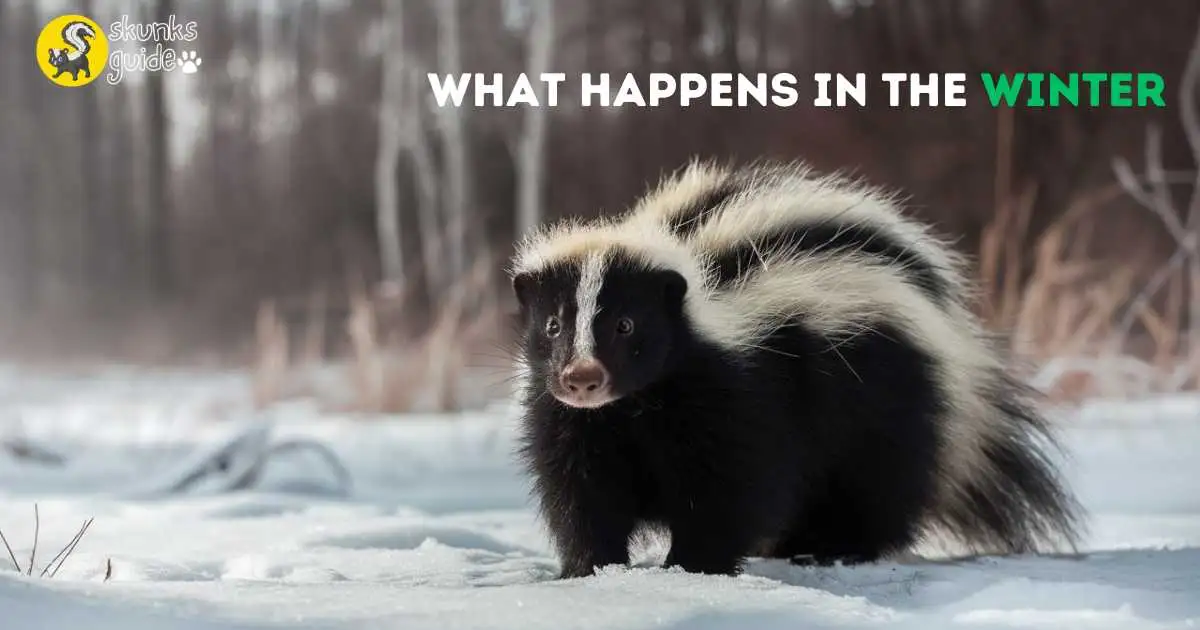What Happens to Skunks in the Winter?
Did you know that skunks don’t hibernate, but instead enter a deep sleep called torpor during the winter? Skunks slow down their bodies and rest in warm dens to survive the cold months. As someone who has spent time studying skunk behavior, I can tell you it’s fascinating how they prepare for winter. Keep reading to learn more about what happens to skunks in the winter and how they make it through the chilly season!
The Secret Life Of Skunks In Winter
Winter transforms the world for skunks. They adapt to colder weather in unique ways. Understanding their behavior helps us appreciate their resilience.
Entering A Winter Wonderland
As winter arrives, skunks face challenges. Snow covers their food sources. They search for shelter in burrows or under fallen trees.
- Skunks prefer to stay warm.
- They often use existing burrows made by other animals.
- Skunks might also dig their own burrows.
These cozy spots protect them from harsh winds and freezing temperatures. Skunks do not hibernate fully. Instead, they slow down and conserve energy.
Hibernation Vs. Torpor: Skunks’ Winter Strategy
Skunks employ a unique strategy during winter. They enter a state called torpor. This is different from true hibernation.
| Feature | Torpor | Hibernation |
|---|---|---|
| Duration | Short-term | Long-term |
| Temperature | Body temperature drops | Significantly lower |
| Activity Level | Occasional activity | Very little activity |
During torpor, skunks can wake up easily. They might venture out to find food. This behavior helps them survive winter.
- Skunks look for insects and plants.
- They store fat to help them survive.
- Finding food can be difficult in deep snow.
Winter is a tough time for skunks. Their clever strategies help them endure the cold months.
Preparing For The Chill
As winter approaches, skunks prepare for the cold. They gather food and find safe places to stay warm. Understanding their behavior helps us appreciate these unique creatures.

Autumn Feast: Skunks Bulking Up
Before winter, skunks eat a lot. This helps them store fat for the cold months. They focus on high-calorie foods. Here are some favorites:
- Fruits
- Insects
- Small mammals
- Eggs
During autumn, skunks can be seen:
- Foraging for food.
- Eating almost anything they find.
- Gaining weight quickly.
This bulking up helps them survive winter’s harshness.
Seeking Shelter: Skunks’ Winter Homes
As temperatures drop, skunks search for warm homes. They prefer safe and cozy places. Common shelters include:
| Type of Shelter | Description |
|---|---|
| Holes in the ground | Deep and sheltered from the cold. |
| Burrows | Used by other animals, they offer protection. |
| Under decks or sheds | Safe from predators and harsh weather. |
Skunks may also share their homes with other animals. This helps them stay warm. They become less active, sleeping for long periods. This is known as torpor. Skunks adapt well to winter, ensuring their survival.
Skunk Activity During The Colder Months
As winter approaches, skunks adapt to the colder weather. They change their behavior to survive. Understanding their activity helps us appreciate these unique creatures.

Not True Hibernators: Skunks’ Winter Movements
Skunks are not true hibernators. They enter a state called torpor. This means they become less active but do not sleep deeply. Skunks may wake up on warm days. They venture out to explore and find food.
- Rest in dens or burrows.
- Reduce their movements significantly.
- Stay warm by curling up together.
During winter, skunks may travel short distances. They often seek shelter in:
- Old tree stumps
- Underground burrows
- Rock crevices
The Search For Food In Snow
Finding food is a challenge in winter. Skunks rely on their keen sense of smell. They dig through the snow to uncover hidden treats.
Skunks mainly eat:
- Insects
- Roots
- Fruits
- Small mammals
They may scavenge from bird feeders or garbage cans. This helps them find extra food sources. Despite the cold, skunks remain resourceful and persistent.
Social Behavior: Solitude Or Socializing?
Skunks display interesting social behaviors during winter. They can be both solitary and social. Understanding their habits helps us appreciate these unique animals.
Winter Solitude: Are Skunks Loners?
During winter, skunks tend to prefer solitude. They seek shelter in burrows or under logs. This behavior keeps them warm and safe. Skunks are not true hibernators, but they do enter a state of dormancy.
- Skunk species, like the striped skunk, often stay alone.
- They find cozy spots to rest.
- Winter is a time for energy conservation.
While skunks are generally solitary, they may share space. This happens in harsh weather. They will not fight over territory. Instead, they seek warmth and safety together.
Rare Interactions: When Skunks Meet
Skunks do not usually socialize in winter. Yet, rare interactions can occur. These meetings are often brief and friendly.
| Interaction Type | Description |
|---|---|
| Friendly Encounter | Skunks may share a den for warmth. |
| Mother and Young | Mothers stay with their young in winter. |
| Male Rivalry | Rarely, males may compete for mates. |
These interactions are brief. Skunks usually go back to their solitary ways. Understanding their social behavior helps us respect their space.
Reproduction And Winter
Winter brings unique challenges for skunks. Their reproductive cycle continues despite the cold. Understanding their mating season and the survival of their young is vital.
Mating Season Timing
Skunks have a specific mating season. This usually starts in late winter. The timing can vary slightly based on location.
- Eastern skunks: Mating occurs from February to March.
- Western skunks: Mating typically happens from late January to early March.
Male skunks seek females during this time. They use scent marking to attract mates. After mating, females enter a gestation period.
Birth And Survival Of Young
Skunks give birth in late spring. The gestation period lasts about 60 to 75 days. This timing ensures young skunks are born in warmer weather.
| Stage | Timeframe | Details |
|---|---|---|
| Gestation | 60-75 days | Female skunks carry the young. |
| Birth | Late spring | Typically between April and May. |
| Weaning | 8 weeks | Young skunks start eating solid food. |
Skunk kits are born blind and helpless. They rely on their mother for warmth and food. After about eight weeks, they begin to explore.
Mother skunks teach their young survival skills. This includes finding food and avoiding predators. The young skunks stay with their mother until fall.
Physical Adaptations To The Cold
Skunks have unique ways to survive winter’s chill. Their bodies change to keep warm. These adaptations help them stay safe and healthy.
Fur Thickening: Skunks’ Natural Coat
Skunks grow thicker fur as winter approaches. This natural coat acts as insulation. It helps trap warmth close to their bodies. The fur also protects them from cold winds.
- Increased fur density
- Longer guard hairs
- Dark undercoat for warmth
This thick fur helps skunks maintain a stable body temperature. They can stay active and find food even in freezing conditions.
Fat Reserves And Metabolism
Skunks build up fat reserves before winter. This extra fat serves as energy. It helps them survive when food is scarce.
| Adaptation | Benefit |
|---|---|
| Fat Storage | Provides energy during food shortages |
| Slower Metabolism | Conserves energy in cold months |
Their metabolism slows down in winter. This change reduces energy needs. Skunks can survive longer without food.
Human And Skunk Encounters In Winter
Winter changes the behavior of skunks. They search for food and shelter. This often leads them to human habitats. Understanding these encounters helps keep both humans and skunks safe.
When Skunks Visit Human Habitats
Skunks are opportunistic feeders. They look for easy meals during winter. Common food sources include:
- Garbage cans
- Bird feeders
- Pet food left outside
Skunks may enter yards or garages. They seek warmth and protection from the cold. Encounters can happen at night when skunks are active.
Be cautious. Skunks can carry diseases. They may also spray if they feel threatened. Understanding their behavior can help avoid conflicts.
Safety Measures For Humans And Pets
Protecting yourself and your pets is vital. Here are some simple safety tips:
- Secure garbage bins with tight lids.
- Remove pet food from outdoor areas.
- Seal entry points in garages and sheds.
- Keep a safe distance if you spot a skunk.
Teach pets to stay away from skunks. Supervise them during outdoor activities. This can prevent unwanted encounters.
Stay calm if a skunk approaches. Moving slowly helps avoid startling the skunk. Remember, skunks only spray as a last resort.
| Tip | Description |
|---|---|
| Secure Trash | Keep garbage bins tightly closed. |
| Remove Food | Take pet food indoors at night. |
| Seal Entrances | Block any holes in your garage or shed. |
| Stay Calm | Do not run or panic if you see a skunk. |
Conservation And Skunk Populations
Understanding the impact of winter on skunks is vital. Cold months can affect their numbers and overall health. Conservation efforts play an essential role in maintaining healthy skunk populations.

Impact Of Winter On Skunk Numbers
Winter poses various challenges for skunks. Food scarcity can lead to lower survival rates. Cold temperatures can also affect their reproduction.
- Food Availability: Skunks rely on insects and fruits.
- Temperature Drops: Extreme cold can lead to hibernation.
- Predation Risks: Starving skunks are more vulnerable.
These factors contribute to changes in skunk populations. It is crucial to monitor these numbers to ensure their survival.
Conservation Efforts For Skunks
Various conservation measures help protect skunk populations. These efforts focus on habitat preservation and public awareness.
| Conservation Measure | Description |
|---|---|
| Habitat Protection | Safeguarding natural habitats from development. |
| Public Education | Teaching communities about skunk behavior and ecology. |
| Monitoring Programs | Tracking skunk populations and health. |
| Rescue Initiatives | Helping injured or orphaned skunks. |
Individuals can also contribute to skunk conservation:
- Plant native vegetation in gardens.
- Avoid using harmful pesticides.
- Report sightings to local wildlife groups.
These actions create a safer environment for skunks. Protecting their habitats ensures future generations thrive.
Frequently Asked Questions
Do Skunks Come Out In The Winter?
Skunks do come out in winter, but their activity decreases. They may emerge on warmer days to search for food. Skunks often seek shelter during colder months, often using burrows or dens. Their behavior varies based on climate and food availability.
Do Skunks Come Back To The Same Place Every Year?
Yes, skunks often return to the same location each year. They may use familiar dens or nesting sites. Factors like food availability and shelter influence their return. If a skunk finds a suitable environment, it will likely come back annually.
How Many Skunks Live In A Den In The Winter?
Skunks typically live alone or in small family groups during winter. A den may host one to three skunks, usually a mother and her young. They seek shelter in burrows or under structures, conserving warmth and energy during colder months.
Conclusion
As winter approaches, skunks adapt to survive the colder months. They enter a state of torpor, slowing their metabolism and seeking shelter. Understanding skunk behavior during winter helps us appreciate these creatures. Observing their habits can also aid in coexisting peacefully with them in our neighborhoods.
Keep learning about wildlife!

